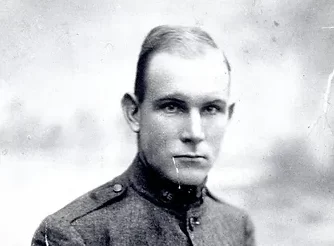Church Hill Firnekas was born late in October 1896 at his father’s homestead on Johnson Creek a few miles northwest of Buffalo.
He left home when he was 12 and went to Sussex just East of Kaycee. He stayed with relatives and continued school for a couple of years. During this time he worked for the Scotch Brothers ZL Bar, a sheep outfit. Someone got sick during that time and needed a doctor. Church rode to Kaycee to phone for a doctor, a round trip ride of at least 70 miles in 1 day. He and his horse rested during the heat of the day at the North Fork of Powder River, and then back to the ZL Bar.
In 1910 he went to work for the Bar C Ranch as horse wrangler, following the round up wagon. He worked off and on for the Bar C Ranch for several years as well as working for a time in construction in the Midwest field with a four-horse team operating a fresno.
The army was purchasing horses for remount outside of Sheridan at the Moncrief facility where the military purchase horses for the war effort. Another job he did was to ride horses past the purchasing agents for selection. Church would ride on to the front of the line, he would unsaddle then walk his saddle to the back and do this over and over all day long.
In 1917 he enlisted in the army and was assigned to Field Remount Squad 910, listed as “horseman” in his pay book. He was stationed in Florida where there were 10,000 horses and mules to be sent overseas. Church and Lee Brumley were charged with roping horses for detachment. He told of them “playing” one day, front footing horses as they came through the water gap. They looked up and there was a full bird colonel watching them from the fence. He said the wings ‘looked like they were 10 feet wide’ and they were trying to make it look as if they weren’t doing anything wrong. The Colonel said “go ahead boys, I was just watching the fun.”
They shipped out with horses for France and the seas were so rough that they couldn’t get close to the shore. Church jumped on a mule and rode him overboard and the horses followed, getting them to shore. They asked him why he did that and he said, “I wanted off that boat.”
His duties included working with, caring for and getting horses to the soldiers in the front lines at night.
After he was discharged when the war was over, he went to the Bar C and during the drought of 1919-1920 trailed a herd of cattle to South Dakota, where he wintered them and trailed them back the next spring. He ran cattle for them for several years.
During this time he trailed horses to Dubois and broke horses for Foster Scott (Double Diamond Ranch) and worked on the Wind River Diversion Dam.
In 1926 he married Maggie Devoe from Barnum and for the next few years leased several places in the area, homesteaded on Sheep Creek and worked for other outfits. In 1936 he bought land in Johnson and Natrona counties on Willow Creek, leased land and started putting together an outfit. They has six children and raised them on that ranch. He ran cattle and sheep and was always well mounted, loving good horseflesh. He loved to rope and was known to his peers as an “all around” roper, a lot of his roping skills were attributed to the army; his specialty was an overhand loop as well as roping over an animal and front footing from the opposite side. He was a true “tie hard and fast” roper. “Don’t throw at it if you don’t want it” he would say.
He was expert at braiding, flat braids, horse hair ropes, head stalls and any kind of tack. He was very capable and could do whatever needed to be done in order to complete a job.
He was a man of integrity, his hand shake was his contract. He taught his family that “a promise made is a debt unpaid”.
He moved his family to Buffalo in 1958, to care for his mother in the last years of her life; however, he could not stay away from the ranch life. In the 1960’s he went to the Buffalo Creek Ranch, in the Red Wall country, and helped gather the cattle and trailed them to where they were to be sold. When they sold he purchased the last end of them, about 40 head, and leased a place in the Buffalo Creek Canyon where he wintered them and sold them the next spring. He was in his late sixties.
Church died in January of 1970. He spent his entire life in the saddle and left a great legacy.


